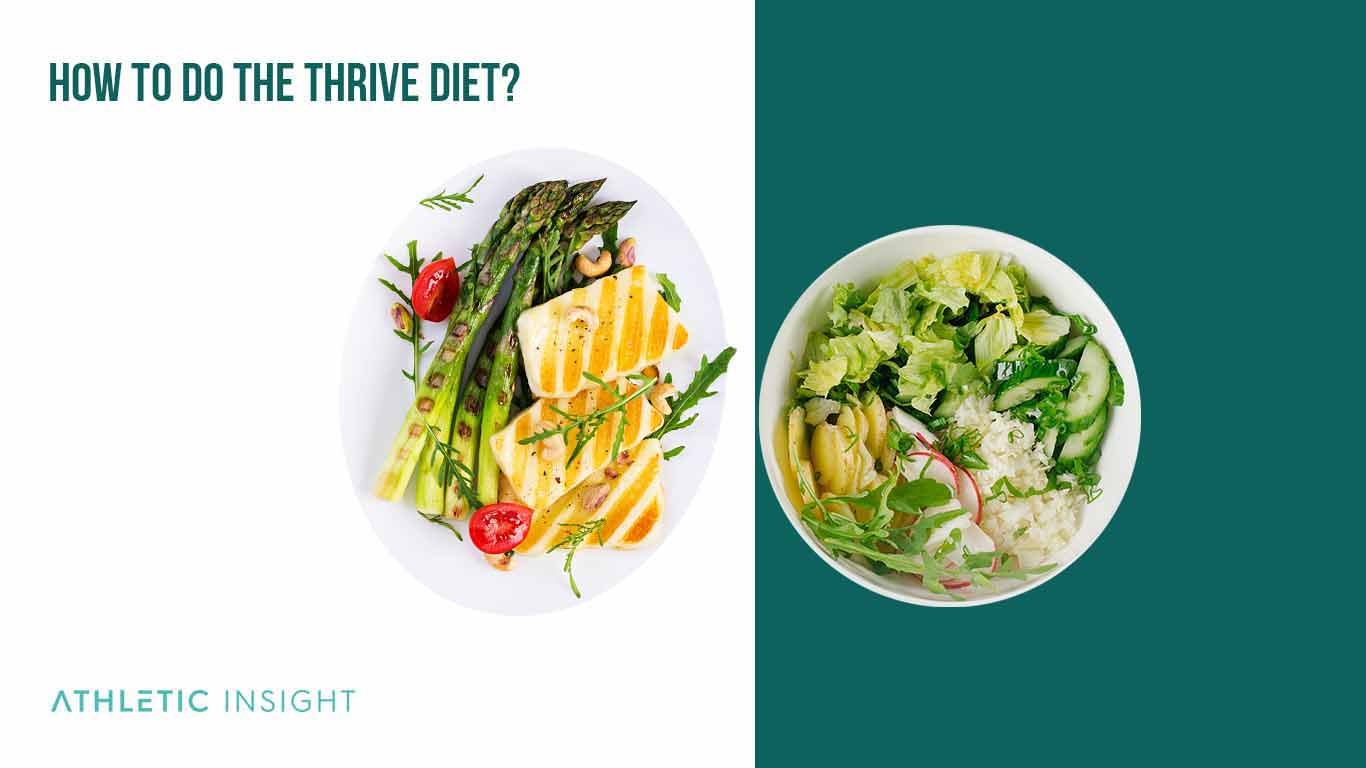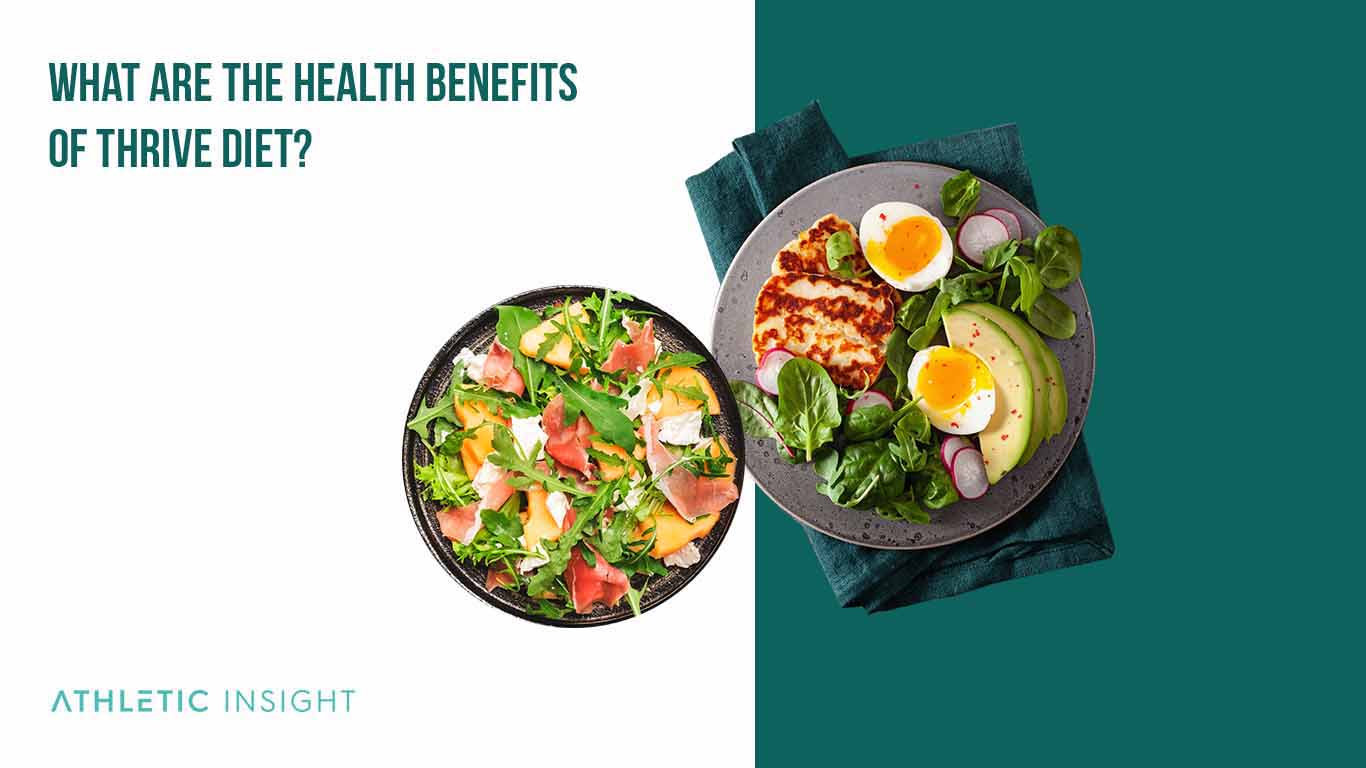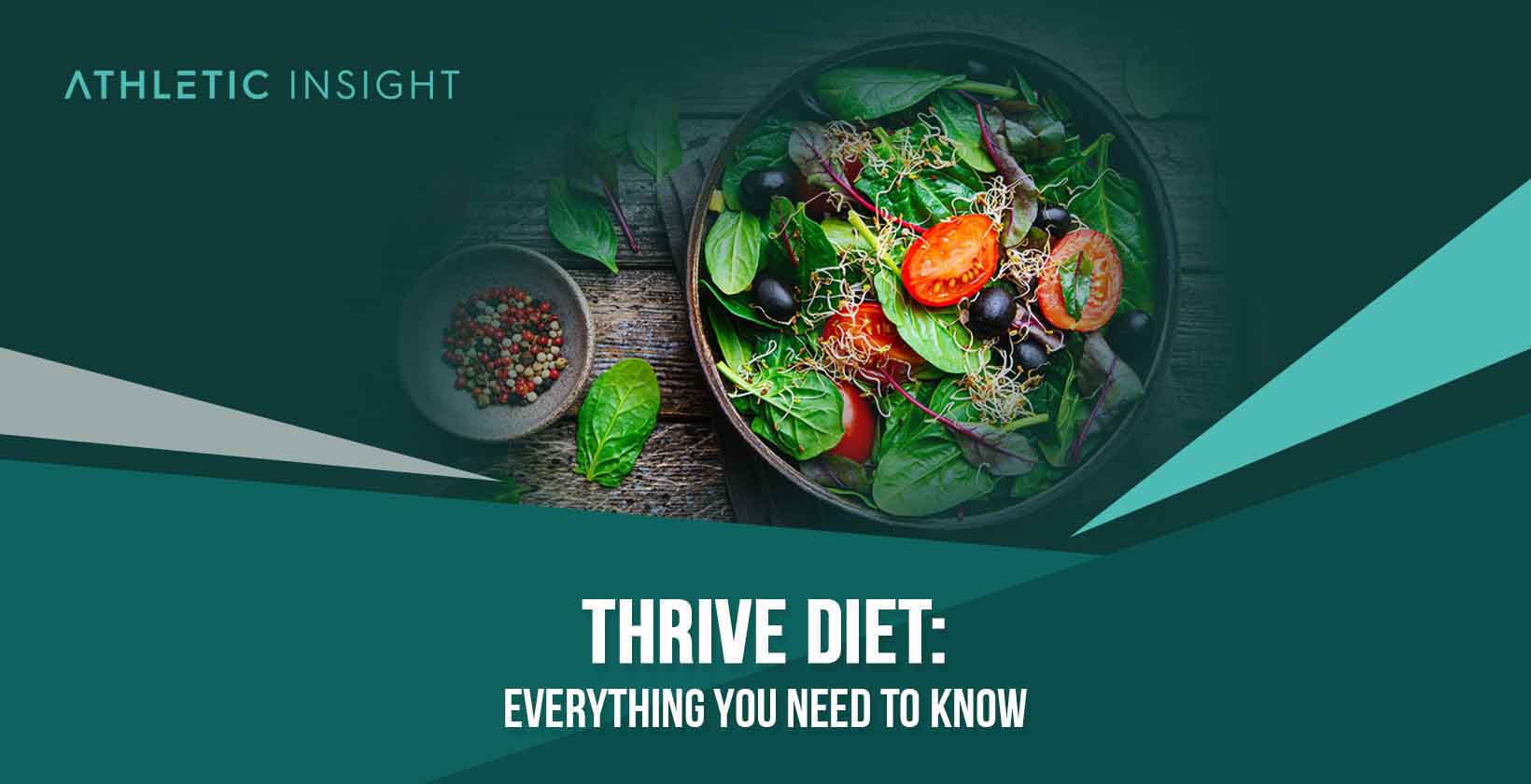The Thrive Diet is a plant-based, nutrient-dense eating plan designed to promote optimal health, increase energy levels, and support weight management. Developed by Brendan Brazier, a former professional Ironman triathlete, the diet emphasizes whole, unprocessed foods rich in nutrients to fuel the body’s natural ability to thrive.
What is Thrive Diet?
The Thrive Diet is a comprehensive nutritional dieting approach that focuses on consuming plant-based, nutrient-dense foods to achieve optimal health, increased energy, and efficient weight management. At its core, the Thrive Diet aims to eliminate processed foods, refined sugars, and unhealthy fats while prioritizing whole, unprocessed foods such as fruits, vegetables, whole grains, nuts, seeds, and legumes.

How Does Thrive Diet Work?
The Thrive Diet works by providing the body with an abundance of essential nutrients, antioxidants, and phytochemicals derived from plant-based sources. These nutrients support the body’s natural ability to heal, detoxify, and maintain optimal functioning.
- Reducing inflammation: By emphasizing anti-inflammatory foods such as dark leafy greens, berries, and omega-3 rich sources like flaxseeds, the Thrive Diet helps to minimize inflammation, which can contribute to various chronic diseases and impede overall health.
- Enhancing digestion and absorption: The high-fiber content in plant-based foods promotes healthy digestion and nutrient absorption, leading to improved gut health and increased energy levels.
- Balancing blood sugar: The focus on complex carbohydrates and low-glycemic foods helps to stabilize blood sugar levels and prevent energy crashes throughout the day.
- Supporting weight management: The nutrient-dense, calorie-sparse nature of plant-based foods aids in weight management by providing essential nutrients without excessive calorie intake.
What is the Main Purpose of Thrive Diet?
The primary purpose of the Thrive Diet is to optimize overall health, increase energy levels, and support efficient weight management through the consumption of nutrient-dense, plant-based foods. The diet encourages individuals to nourish their bodies with whole, unprocessed foods that provide essential nutrients and support the body’s natural ability to heal and thrive.
How to Do the Thrive Diet?
To implement the Thrive Diet, you must adhere to the following steps for optimal results. First, eliminate processed foods, refined sugars, and unhealthy fats from your diet. Then, prioritize whole, unprocessed plant-based foods, such as fruits, vegetables, whole grains, nuts, seeds, and legumes.

Next, focus on anti-inflammatory foods, like dark leafy greens, berries, and omega-3 rich sources. After that, incorporate complex carbohydrates and low-glycemic foods to balance blood sugar levels and maintain consistent energy. Be sure to stay hydrated by drinking plenty of water and herbal teas throughout the day.
Finally, plan balanced meals that include a variety of nutrient-dense foods to ensure adequate nutrient intake. Also, be sure to engage in regular physical activity and prioritize self-care to support overall health and well-being.
- Eliminate processed foods, refined sugars, and unhealthy fats from your diet.
- Prioritize whole, unprocessed plant-based foods, such as fruits, vegetables, whole grains, nuts, seeds, and legumes.
- Focus on anti-inflammatory foods, like dark leafy greens, berries, and omega-3 rich sources.
- Incorporate complex carbohydrates and low-glycemic foods to balance blood sugar levels and maintain consistent energy.
- Stay hydrated by drinking plenty of water and herbal teas throughout the day.
- Plan balanced meals that include a variety of nutrient-dense foods to ensure adequate nutrient intake.
- Engage in regular physical activity and prioritize self-care to support overall health and well-being.
Who Should Do Thrive Diet?
The Thrive Diet is suitable for individuals who want to accomplish the following goals.
- Seek to improve their overall health and well-being through a plant-based, nutrient-dense diet.
- Desire increased energy levels and better mental clarity.
- Wish to maintain or achieve a healthy weight.
- Are interested in reducing inflammation and promoting gut health.
- Want to support athletic performance and recovery through a plant-based diet.
- Are looking for a sustainable and environmentally conscious approach to eating.
How Long Should You Do Thrive Diet?
The Thrive Diet is designed as a long-term, sustainable approach to eating and maintaining optimal health. Rather than being a short-term “diet” with a predetermined duration, the Thrive Diet encourages individuals to adopt a plant-based, nutrient-dense lifestyle that can be maintained indefinitely.
As the diet focuses on whole, unprocessed foods that provide essential nutrients, it can be safely followed for extended periods, providing long-lasting benefits to overall health and well-being.
What are the Phases of the Thrive Diet?
The Thrive Diet is typically divided into three phases; transition, cleanse, maintenance.
- Transition: During this phase, individuals gradually eliminate processed foods, refined sugars, and unhealthy fats from their diet while incorporating more whole, plant-based foods. The duration of this phase may vary depending on individual preferences and previous eating habits.
- Cleanse: In this phase, participants focus on consuming nutrient-dense, anti-inflammatory foods to support the body’s natural detoxification processes. This phase may last between 1-2 weeks and aims to reset the body and improve overall health.
- Maintenance: Once the initial cleanse is complete, individuals continue to follow a balanced, plant-based diet that emphasizes whole, unprocessed foods. This phase is designed for long-term adherence and promotes optimal health, energy, and weight management.
What are the Health Benefits of Thrive Diet?
The Thrive Diet offers numerous health benefits such as improved energy levels and mental clarity, enhanced digestion and nutrient absorption, reduced inflammation and chronic disease risk, balanced blood sugar levels and hormone regulation, support for efficient weight management, improved athletic performance and recovery, promotion of environmental sustainability and animal welfare.

- Improved energy levels and mental clarity.
- Enhanced digestion and nutrient absorption.
- Reduced inflammation and chronic disease risk.
- Balanced blood sugar levels and hormone regulation.
- Support for efficient weight management.
- Improved athletic performance and recovery.
- Promotion of environmental sustainability and animal welfare.
What are the Health Risks of Thrive Diet?
While the Thrive Diet is generally considered safe and healthful, some potential risks include nutrient deficiencies, overemphasis on certain food groups, difficulty adhering to the diet.
- Nutrient deficiencies: As with any restrictive eating plan, it’s essential to ensure adequate nutrient intake, particularly when it comes to vitamin B12, iron, calcium, and omega-3 fatty acids. Consult with a registered dietitian or healthcare professional to ensure proper supplementation if necessary.
- Overemphasis on certain food groups: Variety is crucial for maintaining a balanced diet. Ensure that you consume a diverse range of fruits, vegetables, whole grains, legumes, nuts, and seeds to obtain all the essential nutrients your body needs.
- Difficulty adhering to the diet: Some individuals may find it challenging to transition to a plant-based, nutrient-dense eating plan, particularly if they have been accustomed to a standard Western diet. It’s essential to approach the Thrive Diet with patience and to make gradual changes to promote long-term success.
What are the Foods That You Can Eat While on a Thrive Diet?
Foods to enjoy on the Thrive Diet include fruits, vegetables, whole grains, legumes, nuts and seeds, plant-based protein, healthy fats, and herbs and spices.
- Fruits: Apples, bananas, berries, citrus fruits, kiwi, mango, and pineapple.
- Vegetables: Leafy greens, broccoli, cauliflower, carrots, peppers, and tomatoes.
- Whole grains: Brown rice, quinoa, barley, oats, and whole grain pasta.
- Legumes: Lentils, chickpeas, black beans, kidney beans, and peas.
- Nuts and seeds: Almonds, walnuts, chia seeds, flaxseeds, and pumpkin seeds.
- Plant-based protein sources: Tofu, tempeh, seitan, and edamame.
- Healthy fats: Avocado, olive oil, and coconut oil.
- Herbs and spices: Basil, cilantro, parsley, turmeric, and ginger.
What are the Foods That You Can’t Eat While on a Thrive Diet?
Foods to avoid on the Thrive Diet include processed foods, refined sugars, unhealthy fats, refined grains, animal products, alcohol, and caffeine.
- Processed foods: Chips, cookies, candy, and other packaged snacks.
- Refined sugars: White sugar, high-fructose corn syrup, and artificial sweeteners.
- Unhealthy fats: Trans fats, hydrogenated oils, and excessive saturated fats.
- Refined grains: White bread, white rice, and white pasta.
- Animal products: Meat, poultry, fish, dairy, and eggs.
- Alcohol: Beer, wine, and spirits should be consumed in moderation or avoided altogether.
- Caffeine: Limit or avoid coffee, black tea, and energy drinks, opting for herbal teas and natural energy-boosting alternatives.
What are the Best Recipes for Thrive Diet?
The Thrive Diet offers a variety of delicious and nutritious recipes, such as quinoa and black bean salad, lentil vegetable, chia seed pudding, chickpea and kale stir-fry, and almond buter banana smoothie.
- Quinoa and Black Bean Salad: A protein-packed salad featuring quinoa, black beans, avocado, tomatoes, and a zesty lime dressing.
- Lentil Vegetable Curry: A hearty, flavorful curry with lentils, tomatoes, and a variety of vegetables, served over brown rice.
- Chia Seed Pudding: A creamy, satisfying breakfast or dessert made from chia seeds, almond milk, and your choice of fruit.
- Chickpea and Kale Stir-Fry: A nutrient-dense stir-fry with chickpeas, kale, and other colorful vegetables, seasoned with garlic, ginger, and tamari.
- Almond Butter Banana Smoothie: A quick, energizing smoothie made from almond butter, bananas, plant-based milk, and a touch of cinnamon.
How Long Will It Take to See the Results of Thrive Diet?
The timeline for seeing results on the Thrive Diet may vary from person to person, depending on factors such as individual metabolism, adherence to the diet, and overall health status. However, many individuals report experiencing increased energy levels, improved digestion, and enhanced mental clarity within the first few weeks of following the diet.
More significant changes, such as weight loss or improvements in athletic performance, may take several weeks or months to manifest, depending on individual circumstances and consistency in adhering to the diet.
How Much Does Thrive Diet Program Cost?
The cost of the Thrive Diet program can vary depending on factors such as geographic location, individual food preferences, and shopping habits. Generally, the Thrive Diet emphasizes whole, unprocessed foods, which can be more affordable than processed, packaged foods. By prioritizing seasonal produce, shopping at farmers’ markets, and buying in bulk, individuals may be able to maintain a Thrive Diet on a budget.
What are the Facts About Thrive Diet?
While there are many facts about the Thrive Diet, the following are some of the most important ones.
- Developed by Brendan Brazier, a former professional Ironman triathlete.
- A plant-based, nutrient-dense eating plan focused on whole, unprocessed foods.
- Designed to optimize overall health, increase energy levels, and support weight management.
- May offer benefits such as reduced inflammation, balanced blood sugar levels, and improved athletic performance.
- Encourages environmental sustainability and animal welfare through a plant-based diet.
Is Thrive Diet Considered a Healthy Diet?
Yes, the Thrive Diet is generally considered a healthy diet, as it emphasizes whole, unprocessed plant-based foods that provide essential nutrients and promote overall health. However, it’s crucial to ensure adequate nutrient intake, particularly in the case of vitamin B12, iron, calcium, and omega-3 fatty acids, to maintain optimal health on a plant-based diet.
Does Meal Timing Matter with the Thrive Diet?
No, meal timing is not a primary focus of the Thrive Diet. Instead, the diet emphasizes the consumption of nutrient-dense, plant-based foods to support overall health and well-being. However, individuals may choose to experiment with meal timing to suit their personal preferences, energy needs, and lifestyle factors. Listening to your body’s hunger cues and ensuring adequate nutrient intake throughout the day are more critical than adhering to a strict meal schedule.
Is Thrive Diet for Weight Loss?
Yes, the Thrive Diet can support weight loss by emphasizing whole, unprocessed, nutrient-dense foods that promote satiety and support healthy metabolism. By eliminating processed foods, refined sugars, and unhealthy fats, individuals may naturally reduce their calorie intake and achieve a healthy weight.
However, weight loss should not be the sole focus of the Thrive Diet, as the primary goal is to optimize overall health and well-being through a plant-based, nutrient-dense eating plan.
Is it Possible to Build Muscle While on a Thrive Diet?
Yes, it is possible to build muscle while following the Thrive Diet. The diet includes various plant-based protein sources, such as legumes, tofu, tempeh, and seitan, which can support muscle growth and repair.
By consuming an adequate amount of protein, engaging in regular strength training, and ensuring sufficient calorie intake, individuals can build muscle while adhering to a plant-based, nutrient-dense eating plan like the Thrive Diet.



